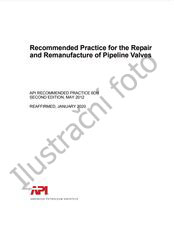Potřebujeme váš souhlas k využití jednotlivých dat, aby se vám mimo jiné mohly ukazovat informace týkající se vašich zájmů. Souhlas udělíte kliknutím na tlačítko „OK“.

API TR 941-A-ed.1
The Technical Basis Document for API RP 941
Přeložit název
NORMA vydána dne 1.6.2019
| Dostupnost | Vyprodáno |
| Cena | NADOTAZ bez DPH |
| NA DOTAZ |
Informace o normě:
Označení normy: API TR 941-A-ed.1
Datum vydání normy: 1.6.2019
Kód zboží: NS-1140769
Počet stran: 425
Přibližná hmotnost: 1306 g (2.88 liber)
Země: Americká technická norma
*) U zboží, které není skladem a musí se objednávat u vydavatele, budou započítány i skutečné náklady na dopravné a balné. Jejich výši Vám sdělíme na základě Vašeho dotazu na e-mailu info@normservis.cz, popř. na telefonním čísle +420 566 621 759.
Anotace textu normy API TR 941-A-ed.1 :
API TR 941-A, 1st Edition, June 2019 - The Technical Basis Document for API RP 941
Abstract
Reports covering a half-century of comprehensive research on hydrogen attack have been reviewed. The major investigators were found to agree about what information would be needed to model the curves presented in API RP 941. However, they concluded that quantification of key, very complex material property and performance inputs is not possible. Prediction of attack limits from first principles, therefore, remains elusive. With the benefit of hindsight, the curves in API RP 941 are explained herein. A series of reasonable assumptions appear to justify Nelson’s placement of the lines for carbon and low alloy steels.
The approach proposed here is applied to these common steels and agrees with trends in attack thresholds established by experience. It is based on the obvious and long-held notions that if the methane pressure in voids is low compared to the material’s strength or methane forming reaction rates are low, attack does not occur. The approach is flexible and can be applied to all carbon and low alloy steels. It can also be used as a starting point to estimate the effect of applied stress on time-dependent behavior.
Application of these models to refinery equipment, especially clad components, has been attempted and the results are credible. Ferritic and austenitic stainless steel overlay and cladding are clearly effective. However, practical implementation of the principles is impeded by uncertainties regarding diffusivity, solubility, absorption rates, and fluxes of hydrogen and the effects of stress and materials strength.
Among the stumbling blocks to successful modeling of hydrogen attack is the lack of knowledge of relevant concentrations and activities of carbon and alloy elements remaining in solution after heat treatment. Also, there is scant knowledge of details about void nucleation and the rates of the methane forming reactions in voids. Local compositions at grain boundaries and the compositions of carbides are probably important, but are not known with certainty. The manner and rate of the evolution of hydrogen attack damage have not been studied quantitatively.
Prediction of attack boundaries is difficult since materials of a grade differ in critical respects and those that have been attacked in service have never been fully characterized (as discussed in Annex A). Systematic laboratory studies of the effects of heat treatment and stress could build confidence in the conclusions offered here and provide valuable information for life assessment and risk evaluation.
Doporučujeme:
EviZak - všechny zákony včetně jejich evidence na jednom místě
Poskytování aktuálních informací o legislativních předpisech vyhlášených ve Sbírce zákonů od roku 1945.
Aktualizace 2x v měsíci !
Chcete vědět více informací? Podívejte se na tuto stránku.



 Cookies
Cookies
